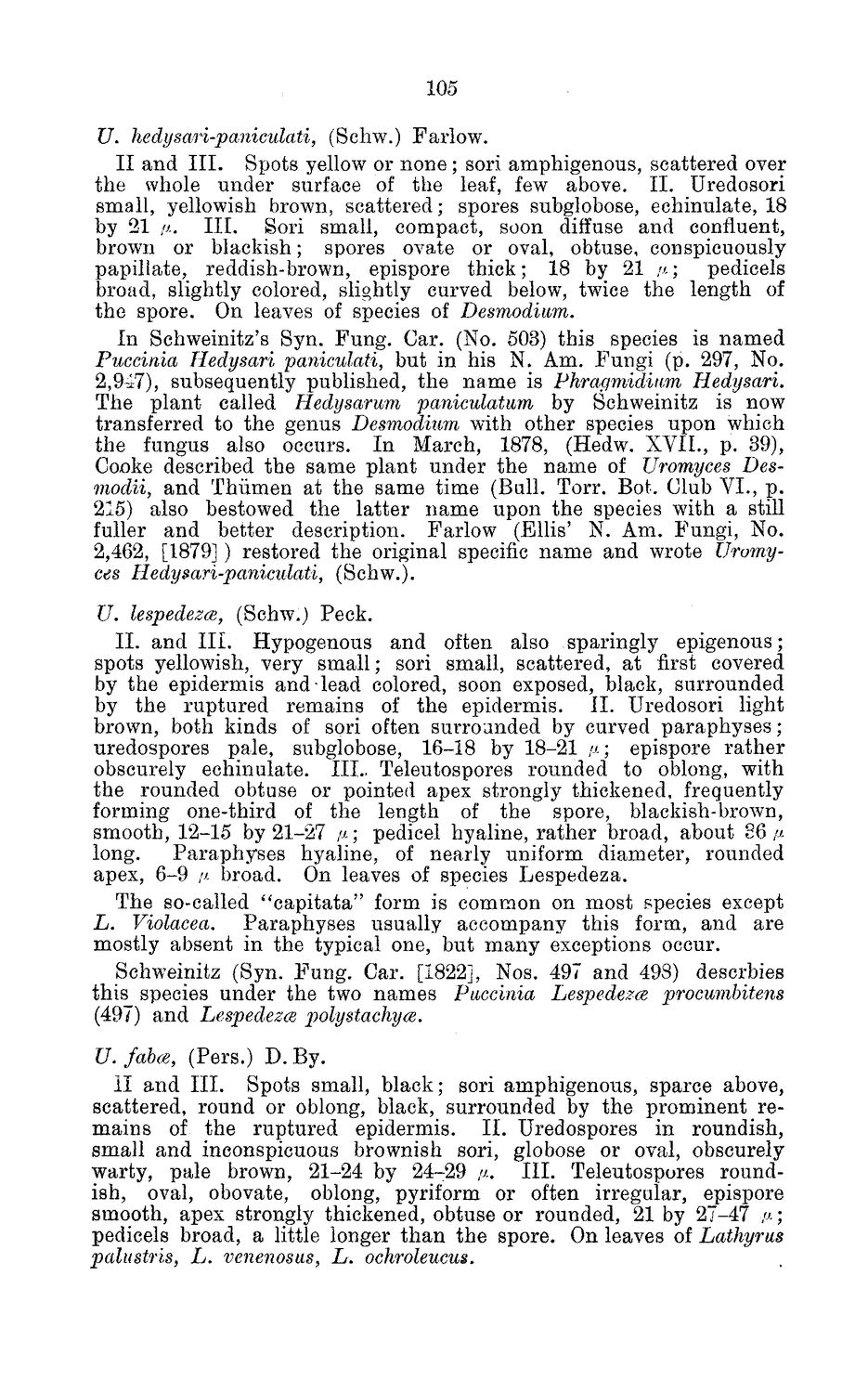| |
| |
Caption: Board of Trustees Minutes - 1884
This is a reduced-resolution page image for fast online browsing.

EXTRACTED TEXT FROM PAGE:
105 U. hedysari-paniculati, (Schw.) Farlow. II and III. Spots yellow or none; sori amphigenous, scattered over the whole under surface of the leaf, few above. II. Uredosori small, yellowish brown, scattered; spores subglobose, echinulate, 18 by 21 //. III. Sori small, compact, soon diffuse and confluent, brown or blackish; spores ovate or oval, obtuse, conspicuously papillate, reddish-brown, epispore thick; 18 by 21 /J. ; pedicels broad, slightly colored, slightly curved below, twice the length of the spore. On leaves of species of Desmodiimi. In Sehweinitz's Syn. Fung. Car. (No. 503) this species is named Puccinia Hedysari paniculati, but in his N. Am. Fungi (p. 297, No. 2,9-17), subsequently published, the name is Phragmidutm Hedysari. The plant called Hedysarum paniculatum by Schweinitz is now transferred to the genus Desmodium with other species upon which the fungus also occurs. In March, 1878, (Hedw. XVII., p. 39), Cooke described the same plant under the name of Uromyces Desmodii, and Thiimen at the same time (Bull. Torr. Bot. Club VI., p. 215) also bestowed the latter name upon the species with a still fuller and better description. Farlow (Ellis' N. Am. Fungi, No. 2,462, [1879]) restored the original specific name and wrote IJromyces Hedysari-paniculati, (Schw.). U. lespedezce, (Schw.) Peck. II. and III. Hypogenous and often also sparingly epigenous; spots yellowish, very small; sori small, scattered, at first covered by the epidermis and lead colored, soon exposed, black, surrounded by the ruptured remains of the epidermis. II. Uredosori light brown, both kinds of sori often surrounded by curved paraphyses; uredospores pale, subglobose, 16-18 by 18-21 n; epispore rather obscurely echinulate. III.. Teleutospores rounded to oblong, with the rounded obtuse or pointed apex strongly thickened, frequently forming one-third of the length of the spore, blackish-brown, smooth, 12-15 by 21-27 n; pedicel hyaline, rather broad, about 8 6 M long. Paraphyses hyaline, of nearly uniform diameter, rounded apex, 6-9 v- broad. On leaves of species Lespedeza. The so-called "capitata" form is common on most species except L. Violacea. Paraphyses usually accompany this form, and are mostly absent in the typical one, but many exceptions occur. Schweinitz (Syn. Fung. Car. [1822], Nos. 497 and 498) descrbies this species under the two names Puccinia Lespedezce procumbitens (497) and Lespedezce polystachyce. U. fabce, (Pers.) D. By. II and III. Spots small, black; sori amphigenous, sparce above, scattered, round or oblong, black, surrounded by the prominent remains of the ruptured epidermis. II. Uredospores in roundish, small and inconspicuous brownish sori, globose or oval, obscurely warty, pale brown, 21-24 by 24-29 ,u. III. Teleutospores roundish, oval, obovate, oblong, pyriform or often irregular, epispore smooth, apex strongly thickened, obtuse or rounded, 21 by 27-47 v-; pedicels broad, a little longer than the spore. On leaves of Lathyrus palustris, L. venenosus, L. ochroleucus.
| |